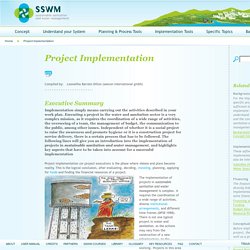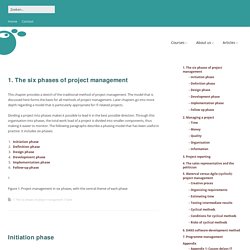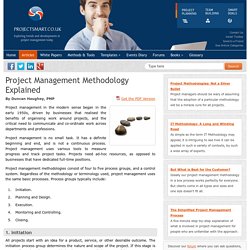

Project Implementation. Project implementation (or project execution) is the phase where visions and plans become reality.

This is the logical conclusion, after evaluating, deciding, visioning, planning, applying for funds and finding the financial resources of a project. Technical implementation is one part of executing a project. Source: WSP (2000) The implementation of projects in sustainable sanitation and water management is complex. It requires the coordination of a wide range of activities, diverse institutional arrangements, and different time frames (DFID 1998). It is important to take into account that independently of the nature of the project, implementation takes time, usually more than it is planned, and that many external constraints can appear, which should be considered when initiating the implementation step (i.e. seasonality in availability of community engagement/resources) (NETSSAF 2008). CARE Project Implementation. PMIG%20english%202009.
1. The six phases of project management. After the project plan (which was developed in the initiation phase) has been approved, the project enters the second phase: the definition phase.

In this phase, the requirements that are associated with a project result are specified as clearly as possible. This involves identifying the expectations that all of the involved parties have with regard to the project result. How many files are to be archived? Should the metadata conform to the Data Documentation Initiative format, or will the Dublin Core (DC) format suffice? May files be deposited in their original format, or will only those that conform to the Preferred Standards be accepted? ERASMUS plus Booklet EVBB. Workshops day 1. Computerizing agricultural cooperatives: a practical guide. Before developing such a plan, pause a moment and reflect on what are some of the key questions the plan will have to address: What are the expected benefits to stakeholders?

What are the risks? What scale of technological solution do you need? What cooperative services are covered? Which personnel will be involved in the process? Once you have given some thought on how you are going to answer these questions, it is time to take the next step: preparation of a detailed project implementation plan.
Take your time, because mistakes can be costly. Skills and Competencies? After the rush of the Ohio HR Conference, October’s monthly HR Roundtable in Cincinnati decided to tackle the topic of “Business/HR Competencies.”

It proved to be a very intriguing subject because the attendees started out a bit stumped with the approach because it seems to be a topic everyone talks about having, but it’s not really defined. Here are the questions they chewed on to get started: What’s the difference between a “skill” and a “competency?” Why aren’t companies “competency” based? What competencies are needed regardless of industry? Even though the topic started slowly, it picked up and jumped ahead!.
The Scrum Guide. Top Tips on Designing a Methodology for your Education Research Project. Top Tips on Designing a Methodology for Your Education Research Project Tip 4: The Golden Rule: Will your data answer your research questions?

There are various factors to consider when deciding on methodology (see ‘A Beginner’s Guide…’, pp.111 112). One of the most important is this: ‘To what extent will the data you collect help you to answer your research questions?’ Here is Charlie’s thinking in this respect: His first research question is about the extent to which spelling and grammar are taught in the school. Timetables, policy documents will provide a general answer to this question, although it may need further checking through other methods. Another of Charlie’s research questions asks about children’s enjoyment or non-enjoyment of these lessons. He can ask a large number of children if they like these lessons ‘Always’, ‘Often’, ‘Sometimes’, ‘Rarely’ or ‘Never’ (a Likert scale), and count responses. Tip 5: Ethics or validity - which is more important? Project Management Methodology. ITS Project Management Methodology provides Information Technology Services (ITS) project teams with a set of standards to initiate and manage individual projects.

The Methodology provides tools to make the project manager’s job a little easier. It contains definitions, guidelines, and templates for the various project management activities needed to deliver successful projects. The Methodology establishes common ground for all projects within UCSC ITS. Project Management Methodology Explained. Project management in the modern sense began in the early 1950s, driven by businesses that realised the benefits of organising work around projects, and the critical need to communicate and co-ordinate work across departments and professions.

Project management is no small task. It has a definite beginning and end, and is not a continuous process. Project management uses various tools to measure progress and track project tasks. Projects need ad-hoc resources, as opposed to businesses that have dedicated full-time positions. Project management methodologies consist of four to five process groups, and a control system. Initiation.Planning and Design.Execution.Monitoring and Controlling.Closing. 1. All projects start with an idea for a product, service, or other desirable outcome.